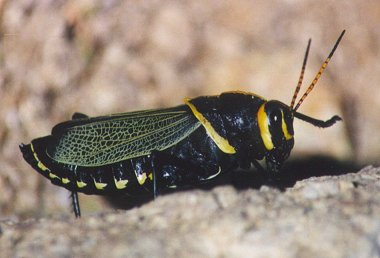The horse lubber grasshopper is primarily
black, with a stout body to 2
½
inches, and has greenish
 front
wings, pink back ones, yellow markings on its body, and black and orange
striped antennae. front
wings, pink back ones, yellow markings on its body, and black and orange
striped antennae.
|
The Horse Lubber Grasshopper can
emit a rank foam when feeling threatened. |
The Horse Lubber lives in grasslands and oak habitats
and ranges from Arizona to Texas and Mexico. The grasshopper spends the
winter in the soil as an egg. In the spring, after rains, the eggs
hatch and the insect matures to an adult between August and November.
These grasshoppers feed on a wide variety of plants including desert
annuals and foliage of perennial shrubs, including mesquite. The Horse
Lubber incorporates toxins from the plants they eat, making them
unpalatable for most predators. Their coloration informs potential
predators that they are poisonous. Males attract females both visually
and acoustically by snapping their fore wings together noisily. |

